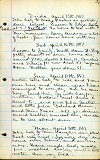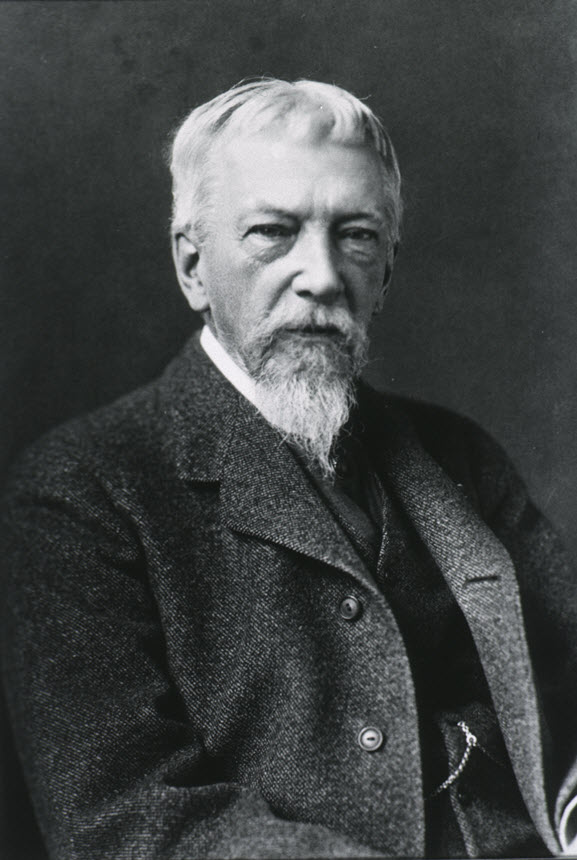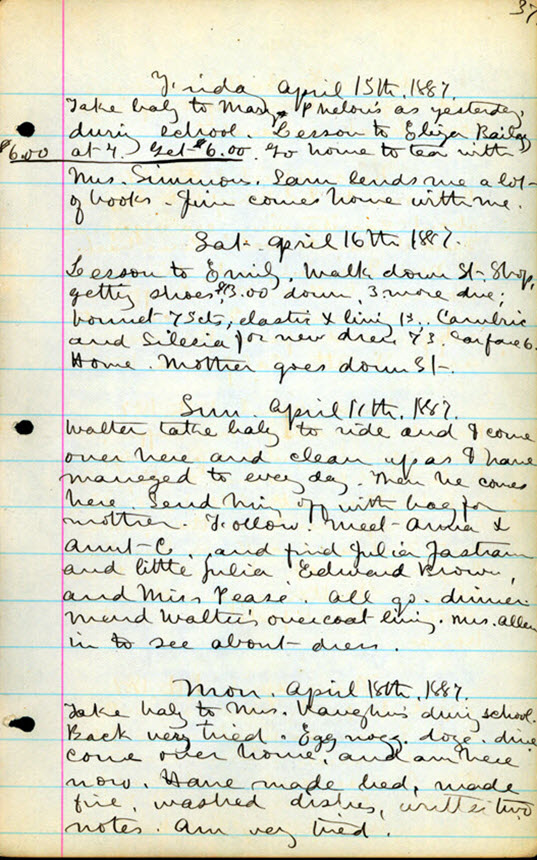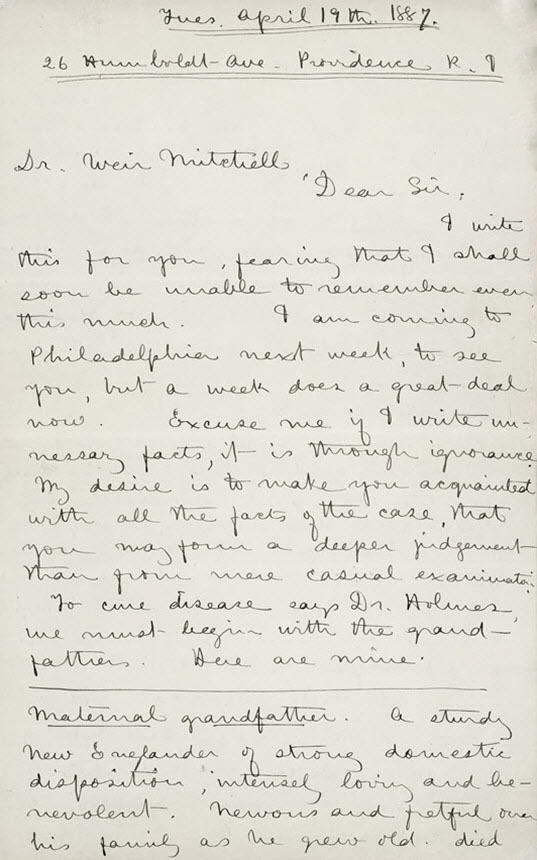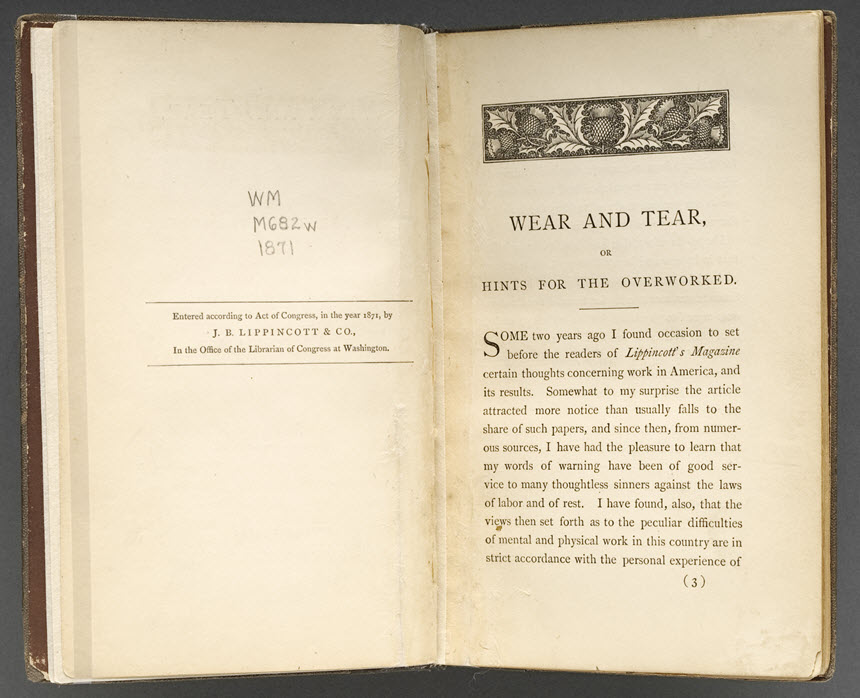After a month of treatment by Mitchell, Charlotte was sent home to continue the regimen of rest. Far from getting better, she became increasingly distressed and began to fear that the method was bad for her health. She decided to end the rest cure and her marriage.
Dr. S. Weir Mitchell, expert on nervous diseases, ca. 1900
Courtesy National Library of Medicine
Charlotte Perkins Gilman consulted nervous diseases specialist Dr. Silas Weir Mitchell for treatment during her unhappy marriage. As one of many medical and scientific experts who debated “the woman question,” he defended the notion of significant differences between the sexes and argued that an epidemic of neurasthenia, or nervous exhaustion, was rife among women who attempted to exceed their natural limits.
Excerpts from Charlotte Perkins Stetson’s Personal Diary, April 15-19, 1887
Courtesy Schlesinger Library, Radcliffe Institute, Harvard University
Charlotte’s first few diary entries describe her everyday tasks as a housewife. In the last few entries, she detailed her deteriorating mental state, and mentioned writing her first letter to Dr. S. Weir Mitchell.
Excerpt from Charlotte’s letter to Dr. S. Weir Mitchell, 1887
Courtesy Wisconsin Historical Society
Charlotte wrote to Dr. Mitchell about her plans to travel to Philadelphia to see him. She requested treatment and described her family history.
Wear and Tear: Hints for the Overworked, S. Weir Mitchell, 1871
Courtesy National Library of Medicine
Mitchell’s writings reflect late 19th-century ideas about female weakness that were used to justify women’s exclusion from schooling, intellectual pursuits, and public life. In one of his classic texts, Mitchell explained how young women could be permanently damaged by over-education. He advocated a cure of complete bed rest and isolation.
Dr. S. Weir Mitchell (front, left) at the Infirmary for Nervous Diseases, Philadelphia, 1902
Courtesy National Library of Medicine
After a month of treatment by Mitchell, Charlotte was sent home to continue the regimen of rest. Far from getting better, she became increasingly distressed and began to fear that the method was bad for her health. She decided to end the rest cure and her marriage.
Dr. S. Weir Mitchell, expert on nervous diseases, ca. 1900
Courtesy National Library of Medicine
Charlotte Perkins Gilman consulted nervous diseases specialist Dr. Silas Weir Mitchell for treatment during her unhappy marriage. As one of many medical and scientific experts who debated “the woman question,” he defended the notion of significant differences between the sexes and argued that an epidemic of neurasthenia, or nervous exhaustion, was rife among women who attempted to exceed their natural limits.
Excerpts from Charlotte Perkins Stetson’s Personal Diary, April 15-19, 1887
Courtesy Schlesinger Library, Radcliffe Institute, Harvard University
Charlotte’s first few diary entries describe her everyday tasks as a housewife. In the last few entries, she detailed her deteriorating mental state, and mentioned writing her first letter to Dr. S. Weir Mitchell.
Excerpt from Charlotte’s letter to Dr. S. Weir Mitchell, 1887
Courtesy Wisconsin Historical Society
Charlotte wrote to Dr. Mitchell about her plans to travel to Philadelphia to see him. She requested treatment and described her family history.
Wear and Tear: Hints for the Overworked, S. Weir Mitchell, 1871
Courtesy National Library of Medicine
Mitchell’s writings reflect late 19th-century ideas about female weakness that were used to justify women’s exclusion from schooling, intellectual pursuits, and public life. In one of his classic texts, Mitchell explained how young women could be permanently damaged by over-education. He advocated a cure of complete bed rest and isolation.
Dr. S. Weir Mitchell (front, left) at the Infirmary for Nervous Diseases, Philadelphia, 1902
Courtesy National Library of Medicine
After a month of treatment by Mitchell, Charlotte was sent home to continue the regimen of rest. Far from getting better, she became increasingly distressed and began to fear that the method was bad for her health. She decided to end the rest cure and her marriage.
After a month of treatment by Mitchell, Charlotte was sent home to continue the regimen of rest. Far from getting better, she became increasingly distressed and began to fear that the method was bad for her health. She decided to end the rest cure and her marriage.



